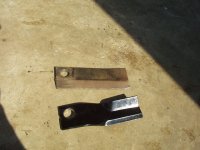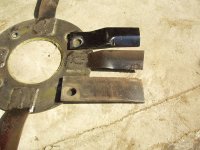Charlie_Iliff
Veteran Member
- Joined
- Jun 13, 2001
- Messages
- 1,896
- Location
- Arnold, MD
- Tractor
- Power Trac PT1845, John Deere 2240, John Deere 950, John Deere 755, Jacobsen Turf Cat II
Attached is a picture of the blade I cobbled up, compared to the stock PT rough cut blade for the 1845's 72" rough cut mower. The purpose of the exercise was intended to be development of finish blades which will do lawn quality cuts, but not self-destruct when encountering a little hump in the soil. (See broken mower blade thread.)
The plan was to put four on each stump jumper, 12 in all, instead of the two per spindle on the rough cut system. The PT finish blades are four per spindle, but rigidly welded to a ring, not free swinging. I'll attach a pic of that to the next post.
The plan was to put four on each stump jumper, 12 in all, instead of the two per spindle on the rough cut system. The PT finish blades are four per spindle, but rigidly welded to a ring, not free swinging. I'll attach a pic of that to the next post.

